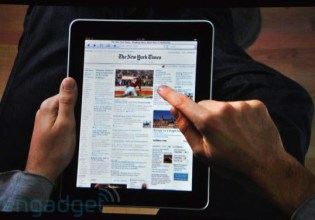 The iPad has been one of the most hyped gadgets of 2010, and I have to say, after just a few days of using one, the buzz is mostly deserved. But what has really grabbed me is the iPad’s potential as a green machine — to the extent it makes the printed page if not irrelevant, then anachronistic.
The iPad has been one of the most hyped gadgets of 2010, and I have to say, after just a few days of using one, the buzz is mostly deserved. But what has really grabbed me is the iPad’s potential as a green machine — to the extent it makes the printed page if not irrelevant, then anachronistic.
Every major publisher, of course, has been salivating over the prospect of cracking the digital conundrum, by creating magazine and newspaper apps that exploit the multimedia magic of tablet computers like the iPad to bring in print-like advertising revenue — all while preserving their dead-tree business.
They better get a move on, though. The iPad, for me at least, is quickly displacing print in all forms.
I already find myself reading, say, the New York Times, on my iPhone throughout the day as I click on NYT Twitter feed links. And though I often have read a good chunk of the Sunday Times online before the paper hits my door that morning, nothing beats curling up on the couch with the doorstop edition on a weekend morning.
Or it did until last Sunday, when I woke up and reached for my brand-new iPad sitting on my bedside table. I fired up the Times app and soon found myself engrossed in the “paper” in all its multimedia glory. The physical version sat wrapped in plastic on my front steps.
Finishing a review of the Chevrolet Volt in the auto section (complete with a photo gallery vividly reproduced on the iPad’s big crystal-clear screen), I fetched the paper and turned to the same story. It looked dull and uninviting, as did the couple of grainy black-and-white photos. I curled up in my favorite chair and continued reading on the iPad.
I’ve gone digital in just about every aspect of my life — I haven’t bought a physical music CD since 2002 — but have stubbornly resisted eBooks. As a member of Generation X plus-or-minus (the lost generation wedged between the baby boomers and Xers), I am attached to physical books as artifacts of my intellectual life.
(When my 12-year-old recently complained about having nothing to read, I scanned my bookshelves and pulled the 1979 paperback edition of The Hitchhiker’s Guide to the Galaxy I had read as teen in the Carter era. Cover price $2.50. If I had been somehow able to download the book in the ’70s, would it still have been accessible 30 years later?)
But as we packed for a trip to visit family in Austin, Texas, I wavered as I contemplated the bulk of William Gibson’s Zero History and Fen Montaigne’s Fraser’s Penguins. As an experiment, I decided to download the iBooks version of the works and see how I liked reading them on the iPad.
I’m hooked.
The crisp backlit text (goodbye reading glasses!) and digital goodies like search and annotation made reading on an e-reader a pleasurable experience. But I’m not ready to part with physical books and probably will fork out the cash to have both digital and dead-tree versions. (Note to publishing industry: This could be a new market segment, aka the nostalgic digerati.)
Not so with magazines. I was so wowed by the New Yorker app that I would gladly trade those piles of the paper edition I feel guilty about hauling to the recycling bin for an iPad subscription.
But am I going to pay $4.99 per issue — or more than $200 a year — for the New Yorker app on top of my $40 print subscription?
Of course not. And therein lies the rub. The technology could save untold tons of greenhouse gas emissions by eliminating tree cutting, pulp manufacturing, and transporting the resulting paper to printers and readers before the whole mess is recycled or hauled to the landfill.
But unless the publishing industry comes up with a viable business model, it ain’t going to happen.
Would I pay a premium to get The New Yorker only as an app to make up for the differential between print ad revenue and iPad ad revenue?
You bet. (Both for the experience and to secure my industry’s future.)
And given the multimedia experience tablets offer advertisers, they should be paying print ad rates.
I eagerly await the Grist iPad app.


